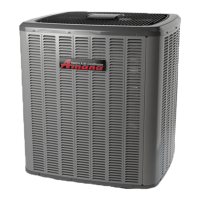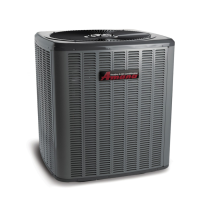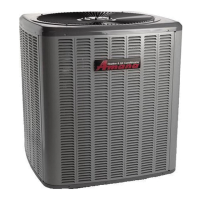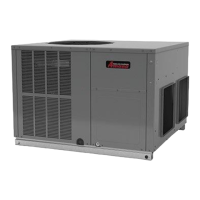15
SERVICING
S-1 CHECKING VOLTAGE
1. Remove outer case, control panel cover, etc., from unit being
tested.
With power ON:
L
INE
V
OLTAGE
NOW
PRESENT
.
WARNING
2. Using a voltmeter, measure the voltage across terminals L1
and L2 of the contactor for the heat pump condenser unit or at
the field connections for the air handler or heaters.
ComfortNet
TM
Ready Heat Pump Condenser Units: Measure
the voltage across the L1 and L2 lugs on the unitary (UC) con-
trol.
3. No reading - indicates open wiring, open fuse(s) no power or
etc., from unit to fused disconnect service. Repair as needed.
4. With ample voltage at line voltage connectors, energize the
unit.
Voltage Min. Max
208/230 197 253
Unit Supply Voltage
NOTE: When operating electric heaters on voltages other than
240 volt, refer to the System Operation section on electric heaters
to calculate temperature rise and air flow. Low voltage may cause
insufficient heating.
S-2 CHECKING WIRING
HIGH VOLTAGE !
D
ISCONNECT
ALL
POWER
BEFORE
SERVICING
OR
INSTALLING
. M
ULTIPLE
POWER
SOURCES
MAY
BE
PRESENT
. F
AILURE
TO
DO
SO
MAY
CAUSE
PROPERTY
DAMAGE
,
PERSONAL
INJURY
OR
DEATH
.
WARNING
1. Check wiring visually for signs of overheating, damaged insu-
lation and loose connections.
2. Use an ohmmeter to check continuity of any suspected open
wires.
3. If any wires must be replaced, replace with comparable gauge
and insulation thickness.
S-3 CHECKING THERMOSTAT AND WIRING
ComfortNet™ Ready Models
Communicating Thermostat Wiring: The maximum wire length for
18 AWG thermostat wire is 250 feet.
S-3A THERMOSTAT AND WIRING
L
INE
V
OLTAGE
NOW
PRESENT
.
WARNING
With power ON, thermostat calling for cooling/heating.
1. Use a voltmeter to check for 24 volt at thermostat wires C and
R in the indoor unit control panel.
2. No voltage indicates trouble in the thermostat, wiring or trans-
former source.
3. Check the continuity of the thermostat and wiring. Repair or
replace as necessary.
With power ON:
L
INE
V
OLTAGE
NOW
PRESENT
.
WARNING
Resistance Heaters
1. Set room thermostat to a higher setting than room tempera-
ture so both stages call for heat.
2. With voltmeter, check for 24 volt at each heater relay.
3. No voltage indicates the trouble is in the thermostat or wiring.
4. Check the continuity of the thermostat and wiring. Repair or
replace as necessary.
NOTE: Consideration must be given to how the heaters are wired
(O.D.T. and etc.). Also safety devices must be checked for continu-
ity.
S-3E CTK04** COMFORTNET™ THERMOSTAT
OVERVIEW
The ComfortNet™ system (or CT system) is a system that includes
a ComfortNet compatible modular blower heat pump condenser
with a CTK04** thermostat. The table below compares the valid
CT systems.
CT compatible Air Handler
or Modular Blower
CT compatible
Heat Pump Unit
Full CT system
benefits &
features
A ComfortNet heating/air conditioning system differs from a legacy/
traditional system in the manner in which the indoor unit, out-
door unit and thermostat interact with one another. In a tradi-
tional system, the thermostat sends commands to the indoor and
outdoor units via analog 24 VAC signals. It is a one-way commu-
nication path in that the indoor and outdoor units typically do
not return information to the thermostat.
On the other hand, the indoor unit, outdoor unit, and thermostat
comprising a ComfortNet system “communicate” digitally with
one another. It is now a two-way communications path. The
thermostat still sends commands to the indoor and outdoor units.

